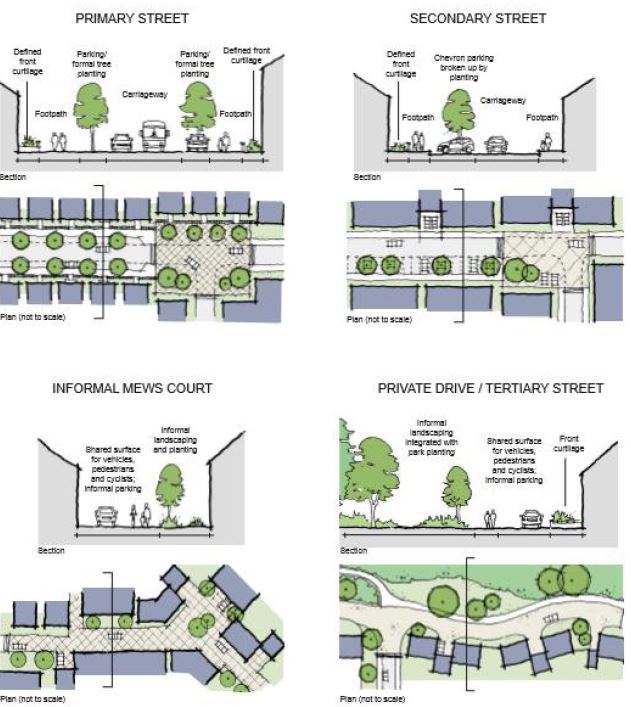A residential street should be seen, as much as possible, as an extension of the homes that it serves. The quality of our streets and spaces can be undermined by overly engineered traffic calming measures such as speed ramps and raised platforms. This type of traffic calming is unattractive and can be frustrating for all users. Natural methods of traffic calming can include narrowing the carriageway, use of planting, street trees and changes in surfacing or creation of shared space.
Sustainable urban draining (SuD’s) should be designed into streets at an early stage and used imaginatively to provide unique features that help identify a specific route through or aid legibility. When designing the street network careful consideration should be given to green infrastructure and how this overlays the movement corridors to create a joined up wider network of footpath, cycle paths and bridleways.
If you plan to design for the elderly and disabled, you design for all. This is inclusive design. Sensory-rich environments are place s that attract a diverse range of visitors and have benefits for disabled people.
Good residential schemes have a relationship between streets, space and buildings and exhibit an active ground floor to facilitate animated and interesting streets. The presence of active windows to habitable rooms aids overlooking and increases natural surveillance. Active frontages with overlooking windows also give the impression that the street is in constant use and therefore less likely to be subject to petty crime, vandalism and antisocial behaviour. Careful housing design will ensure that internal privacy and active overlooking from the house are both secured, for example by placing living room rather than bedroom windows facing the street at ground floor level.
Traffic speeds within residential areas should be a maximum 20-25mph in main connector streets, with 20mph in local streets, 15mph in shared surface areas, and 10mph in Home Zones.
Rather than the use wholesale use of bland unappealing tarmac, grater variety of surfacing and footpath definition will also be sought to create more attractive streetscape. This can help in creating a greater sense of shared space which often indirectly reduces traffic speeds. Keeping speeds down and the environment safe should be one of the main aims of any residential street.

Street Hierarchy
Cromer & Protection
Good design can have a huge influence on resultant crime levels. The following measures can be incorporated into layouts to aid crime prevention:
- The entrance to a development can be clearly marked with a change of surface, enclosure definition or gateway. This gives the impression that the area beyond the symbolic barrier is private.
- The number of access roads can be minimised to control vehicle movement and reduce unnecessary through traffic.
- The site can be kept as open as possible to create good natural surveillance, particularly overlooking footpaths and play areas.
- Footpath and alleyways should be design to exclude hiding places and always be well lit and follow the most direct route.
- Security should be enhanced by the physical protection of strong doors and secure windows.